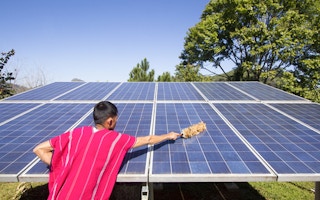Energy powers our modern lives. It is also the major cause of global warming. Over 70 per cent of the gases that trap the heat in our atmosphere are caused by the burning of fossil fuels—coal, oil and gas—to produce energy.
The cost of renewable sources of energy is declining rapidly, and renewable energy has started to replace fossil fuels, especially in the production of electricity.
However, this transformation is not happening fast enough. DNV GL, an independent third-party provider of assurance and risk management services to the energy sector headquartered in Norway, just published their “Energy Transition Outlook 2019”, an analysis of the demand-and-supply aspects of the energy transformation.
Looking into the future, the report concludes that global average temperatures are likely to increase by 2.5° Celsius by the end of the century, compared to pre-industrial levels, despite the considerable progress that has been achieved, such as efficiency gains due to digitalisation and electrification, regulatory changes such as carbon pricing, and anticipated further cost reductions for renewables.
Using the best available information, the DNV GL report goes into great detail analysing trends and possible developments that affect the energy transformation. It predicts a continued rise in renewable sources of energy that are not depleted by use, such as water, wind, and solar power.
The report also predicts significant learning effects due to scale and technological progress, improved grid systems and the rapid growth of electricity, increasingly produced by renewables. The share of electricity in final energy demand is expected to increase from currently 19 per cent to over 40 per cent by 2050.
By mid-century, 63 per cent of the world’s electricity will be supplied by solar photovoltaics and wind. Half of all new passenger vehicle sales, for example, are estimated to be electric by 2032.
On the other hand, the demand for oil is projected to peak and flatten in the early 2020s and coal will see rapid declines. Gas will continue to play an important role for years to come.
“
By mid-century, 63 per cent of the world’s electricity will be supplied by solar photovoltaics and wind.
The transformation of energy will be driven forward by several key factors: the continued impact of digitalisation, subsequent improvements in asset utilisation, advances in key technologies, such as battery technology, and further improvements in solar photovoltaic systems. China alone will account for 40 per cent of solar installations by 2050.
A watershed year is predicted for 2034, when non-fossil fuel capital expenditures are expected to exceed fossil fuel expenditures for the first time.
All the technologies needed to meet the Paris Climate goals, including the 1.5° C goal, are already available, and the economic case for accelerating the decarbonisation of energy systems is compelling, not only in terms of avoiding damage.
The transition is also affordable and will lead to major cost reductions over time. Initial investments required to build decarbonised energy systems are significant—the report estimates that the forecast’s global energy expenditures would need to increase from today’s US $ 4.5 trillion to US $ 5.5 trillion by 2050.
However, the rise of low-cost and smart electricity will bring about enormous operating savings. Total energy expenditures as a share of GDP are predicted to fall from 3.6 per cent in 2017 to 1.9 per cent by 2050.
Scientists tell us that the window of opportunity for reducing the emissions of greenhouse gases that cause global warming is closing fast. Accelerating the decarbonisation of energy systems is a complex undertaking.
Changes in such massive systems have historically taken many decades. The shift from wood and dung to coal, from coal to oil and from oil to gas played out over centuries and each of these transitions is still concurrently unfolding across the globe.
As of today, hundreds of millions of people still lack access to modern forms of energy and have to rely on wood and dung for cooking and heating. Governments around the world subsidise fossil fuel production and consumption as a means to foster industrialisation.
At this time, such “perverse” subsidies are estimated by the International Monetary Fund (IMF) at US$1 trillion per year. Phasing out these subsidies would seem a first necessary and long overdue step. But in the absence of strong political will to support international cooperation, it is difficult to see how and why less developed countries would forgo the option of cheap fossil fuels to meet basic needs.
Climate finance as promised at the 2015 Paris meeting could have helped to avoid the recent construction of many new coal-fired power plants in Asia and Africa, which will be adding to the legacy of our industrial era for decades to come. But alas, as economic nationalism and ethnic chauvinism have taken roots, the willingness for international cooperation has dwindled, and with it the willingness to cooperate.
Leading by example and embracing the post-industrial era powered by clean electricity and smart technologies would seem to be the way to go for all countries. A growing number of less-developed countries already have the option to leapfrog classic industrial-era stages that rely on fossil fuels.
But so far, only a select few countries in the world, mostly China and European countries, have embraced decarbonisation and digitalisation as a national priority and strategy, both to modernise industries and to improve competitiveness, while reducing emissions.
As the impact of climate change is becoming more visible and as people’s lives are increasingly affected by it, one can expect that pressure on governments will increase over time. This will lead to more drastic measures, including much higher prices for carbon as is currently under consideration and new investments into smart grid systems and technologies that substitute fossil fuels with clean electricity.
We can already see how young people are mobilising in many countries and how their impatience is shaking up policy makers whose historical context is the industrialisation era.
Finance is another leverage that has not been fully utilised. Price signals do not yet account for emissions and pollution and it still makes financial sense to burn the globe. However, a silent revolution is currently reshaping the industry.
The Central Banks and Supervisors Network for Greening the Financial System (NGFS), a group of banks that support climate risk management in the financial sector, has declared climate risks a systemic risk that will be monitored alongside macroeconomic trends. Other initiatives enable investors and corporations to better assess climate risks and frame strategies that support corporate transformations.
Examples are the Task Force on Climate-Related Financial Disclosures (TCFD) which encourages companies to disclose information to enable financial markets understand climate-related financial risks and opportunities, and Climate Action 100+, an investor initiative that encourages the world’s largest corporate greenhouse gas emitters to take necessary action on climate change.
At the same time, technology now empowers investors with new tools, such as Arabesque S-Ray, which enables investors to get a better handle on environmental, social and governance (ESG) factors. Investors are already starting to relocate capital away from companies that are pollution-intensive towards cleaner and more future-fit companies.
Over US$30 trillion investments are using ESG frameworks. Other green finance tools, such as green bonds, are on the rise as well.
Corporations have long pursued efficiency measures to reduce emissions in order to save costs and to meet regulatory requirements.
The prospect that fossil fuel subsidies will get phased out over time and be replaced by pricing schemes for emissions and by tougher performance standards has become a powerful motivator for companies to take decarbonisation more seriously, as is evident, for example, with the UN Global Compact’s Business Ambition for 1.5° C. campaign.
Decarbonisation is now increasingly seen as a systemic and structural factor that affects long-term competitiveness, often in conjunction with technology shifts.
Examples are German automaker Volkswagen, which is massively investing in e-mobility and digitalisation, and Norway-based energy company Equinor, which is increasingly investing in offshore wind generation and scalable carbon capture and storage (CCS).
The rise of sustainable finance and the new corporate drive to accelerate decarbonisation, in conjunction with digitalisation, can add new momentum to the energy transformation. But for these market-led forces to become the new normal, they require an enabling and supportive policy environment.
Policy makers need to realise that decarbonisation and technological change are long-term systemic forces that shape the prosperity and safety of societies. Embracing them is a winning strategy for people and the planet and maybe, just maybe, DNV GL’s forecast of a 2.5 degree temperature can be proven wrong!
Georg Kell is the chairman of Arabesque and the former executive director of the United Nations Global Compact.











